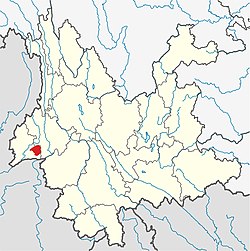Chiefdom of Mangshi
Chiefdom of Mangshi 芒市土司 | |||||||||
|---|---|---|---|---|---|---|---|---|---|
| 1443–1955 | |||||||||
 Territory in modern Yunnan | |||||||||
| Status | Native Chiefdom of China | ||||||||
| Capital | Mangshi | ||||||||
| Common languages | Tai Nuea language | ||||||||
| Government | Monarchy | ||||||||
| Tusi | |||||||||
• 1443–1459 | Fang Dingzheng (first) | ||||||||
• 1948–1955 | Fang Yulong (last) | ||||||||
| History | |||||||||
• Established | 1443 | ||||||||
• Disestablished | 1955 | ||||||||
| |||||||||
| Today part of | China | ||||||||
The Chiefdom of Mangshi, officially Mangshi Yuyi Zhangguansi and Mangshi Anfusi was a Dai autonomous Tusi chiefdom in the west of Yunnan, China from 1443 to 1955. In 1443, the Ming dynasty established Mangshi Yuyi Zhangguansi (芒市御夷长官司) because a Mangshi chief made a contribution in Luchuan–Pingmian campaigns, and then upgraded to Mangshi Anfusi (芒市安抚司) in 1640. Chiefdom of Mangshi has an absolute dictatorship in politics, military, economy at the territory, and use the rule of primogeniture.[1]
In the Republic of China period, the central government used many methods try to abolish the Chiefdom of Mangshi, for example, established a direct control government "Luxi Administrate Bureau" (潞西设治局).[1] But the Chiefdom of Mangshi allied with other chiefdoms to counteract the abolishment. At its worst, chiefdoms had a consideration for independence from China. Finally, the central government compromised with chiefdoms.[2]
After People's Republic of China controlled this area, the central government launched the Chinese Land Reform Movement. The last Chief of Mangshi, Fang Yulong lost his power and land, finally abolished in 1955.[3]
Chaophas
[edit]Chiefdom of Mangshi contains 24 official Chaophas in history.[1]: 482
| Generation | Name in Chinese | Name in Pinyin | Period | Duration | Notes |
|---|---|---|---|---|---|
| 1 | 放定正 | Fang Ding-zheng | 1443-1459 | 16 | |
| 2 | 放贞 | Fang Zhen | 1465-1487 | 22 | Son |
| 3 | 放革 | Fang Ge | 1506-1518 | 12 | Son |
| 4 | 放辅 | Fang Fu | 1523-1542 | 19 | Son |
| 5 | 放福 | Fang Fu | 1543-1573 | 30 | Son |
| 6 | 放国忠 | Fang Guo-zhong | 1573-1591 | 18 | Son, marriage with Yue Feng's daughter, who betrayed Ming. He was killed by Ming in 1591 with his father Fang Fu. |
| 7 | 放纬 | Fang Wei | 1592-1595 | 4 | Fang family's relatives |
| 8 | 放珀 | Fang Po | 1596-1639 | 43 | Second son |
| 9 | 放廷臣 | Fang Ting-chen | 1640-1647 | 7 | Son |
| 10 | 放国璋 | Fang Guo-zhang | 1648-1658 | 10 | Son |
| 11 | 放爱众 | Fang Ai-zhong | 1661-1664 | 3 | Son |
| Acting | 放廷弼 | Fang Ting-bi | 1668-1673 | 5 | Fang Ting-chen's little brother |
| 12 | 放弥高 | Fang Mi-gao | 1673-1685 | 12 | Fang Ai-zhong's son |
| Acting | 放弥合 | Fang Mi-he | 1685-1694 | 9 | Fang Mi-gao's little brother |
| 13 | 放天球 | Fang Tian-qiu | 1696-1713 | 17 | Fang Mi-gao's son |
| 14 | 放仁 | Fang Ren | 1716-1738 | 22 | Son |
| 15 | 放作藩 | Fang Zuo-fan | 1741-1770 | 29 | Son |
| 16 | 放愈彰 | Fang Yu-zhang | 1771-1772 | 1 | Son |
| Acting | 放作藩 | Fang Zuo-fan | 1772-1774 | 2 | |
| 17 | 放愈著 | Fang Yu-zhu | 1774-1796 | 22 | Fang Zuo-fan's second son |
| 18 | 放泽重 | Fang Ze-zhong | 1798-1816 | 18 | Son |
| Acting | 放愈新 | Fang Yu-xin | 1816-1821 | 5 | |
| Acting | 放泽浩 | Fang Ze-hao | 1821-? | ? | Fang Ze-zhong's elder cousin |
| 19 | 放承恩 | Fang Cheng-en | 1826-1849 | 23 | Son |
| Acting | 放世恩 | Fang Shi-en | 1851-1858 | 7 | Fang Cheng-en's little brother |
| 20 | 放庆禄 | Fang Qing-lu | 1875-1877 | 2 | Fang Cheng-en's step-son, Fang Shi-en's son |
| Acting | 放庆寿 | Fang Qing-shou | 1879-1889 | 10 | Fang Zheng-de's uncle |
| Acting | 放庆雍 | Fang Qing-yong | 1889-? | ? | Fang Zheng-de's uncle |
| 21 | 放正德 | Fang Zheng-de | 1889-1910 | 21 | Fang Qing-lu's son |
| 22 | 方克明 | Fang Ke-ming | 1910-1931 | 21 | Son |
| 23 | 方云龙 | Fang Yun-long | 1933-1936 | 3 | Son |
| Acting | 方克光 | Fang Ke-guang | 1936-1953 | 17 | Fang Zheng-de's 3rd son |
| Acting | 方克胜 | Fang Ke-sheng | 1944-1948 | 4 | Fang Zheng-de's 4th son |
| 24 | 方御龙 | Fang Yu-long | 1948-1955 | 7 | Fang Ke-ming's 5th son |
| Acting | 方化龙 | Fang Hua-long | 1953-1955 | 2 | Fang Ke-guang's son |
References
[edit]- ^ a b c 云南省潞西县志编纂委员会 (1993). 潞西县志 [Annals of Luxi County] (in Chinese). Kunming: Yunnan Education Publishing House. ISBN 7-5415-0685-0.
- ^ 王春桥 (2015). "土司存废与国家统一(1944~1948)" [Maintenance or abolishment of Tusi chieftain system and unification of China (1944-1948)]. Journal of Yunnan Minzu University (Social Sciences) (in Chinese). 32 (1): 103–108. doi:10.13727/j.cnki.53-1191/c.2015.01.015.
- ^ 德宏史志编委会办公室 (1986). 德宏史志资料 第七集 [Annals material of Dehong, Volume 7] (in Chinese). Mangshi: Dehong Nationalities Publishing House.
